#native plants of eastern united states
Text
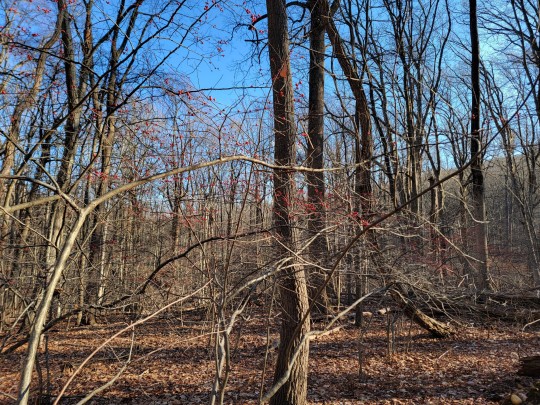

Winterberry Holly - Ilex verticillata
When I was a child, In winter we would drive past the misty floodplains of the Rockaway river where I would see cattails and red berries pop among the snow-covered forests. These charismatic plants are winterberries.
The term winterberry is often applied to specific members of the holly family, the term can refer to I. laevigata, I. montana and certain asian species as well like I. serrata. Like the name implies the winterberry is attributed to it's bright red fruit (female plants only) present from early autumn into winter. These are relatively common species in the nursery trade, although typically you'll find more compact showy cultivars than you would see naturally.
Winterberry plants are deciduous, understory shrubs, usually found in moist-flooded soils, which can grow up to 10 feet in height. In nature it's very common to find these growing in wetlands in semi-dense stands, they enjoy acidic soils however can thrive in neutral as well. These can be found basically the entire eastern US east of the Mississippi river.
To propagate winterberries: growing from seed is relatively difficult and I've had no luck, they need quite a few seasons to sprout. Cuttings in spring take relatively easily but in the wild its most common for plants to spread via colonal rooting.
The berries are sometimes confused with an aggressive invasive vine oriental bittersweet (orange-yellow multi-bunch fruits), you can easily distinguish them by paying attention to the stem structure from which they derive, and the winterberries single red round fruits which attach to the buds of branches.
#plant profiles#east coast native shrubs#native plants of eastern united states#winterberry#ilex verticillata
10 notes
·
View notes
Text
Tree stuff
Most trees should outlive you. If a landscaper tells you the lifespan of a tree is 10 years, they don't know what they're talking about.
Trees are free. Carefully comb over your yard for baby trees, especially in mid-spring!
Similarly, If you live near a gravel driveway or gravel parking lot, you can find baby tree sprouts that can be easily transplanted by gently removing the gravel bits from around the roots, wrapping the roots in wet paper towel, and transplanting to a large pot.
Do not pile up mulch around the base of a tree. You can mulch under the tree, but it should be a mostly flat layer, not a raised mound, and keep the mulch a few inches away from touching the trunk. Roots need some access to air or the tree will grow roots upward through the mulch, and the roots will slowly wrap around the trunk and strangle the tree to death. It's called root girdling and it is very sad.
Trees need friends!!! If possible, plant two or three trees instead of just one. Trees share nutrients through the mycorrhizal network and they protect each other from storm damage.
Always get a tree that is native to your area and suited to your local environment.
Growing an oak from an acorn is easy. Go to an area where there are oaks in the fall, and collect the acorns that have turned brown and whose hats have popped off. Get large pots at least 8 inches depth, and lay the acorns on their sides on top of the potting soil, then cover them with a layer of damp fallen leaves, and leave them outside all winter long. Just be sure to cover them with some wire mesh or something to protect them from squirrels
Please keep oaks and other large trees about 20 feet from any structure because they will grow huge. Websites will tell you to keep trees X distance away from "structures or other trees" but other trees can go as little as 6-10 feet apart whereas structures need to be like 15 feet away minimum, generally speaking
Prune the tree while it's dormant, NOT in the middle of summer!
If you happen to be from the Eastern United States, please consider getting an oak! They are keystone species and host plants for literally hundreds of insects. We have too many maples here too, so maybe consider a Sweetgum or Black Gum for pretty fall colors?
If you have a tree that's tied to a stake to keep it upright, get rid of that thing as soon as you can, particularly if there's zip ties holding it to the tree, because those can grow into the bark and kill the tree...
If your tree is dead, please consider cutting off the branches and leaving at least 6-10 feet or so of trunk standing. Dead tree snags like this are important nesting places for many birds and you might see a woodpecker
If you live in North America, whatever you do, do NOT get anything marketed as an "ornamental flowering pear tree." They're typically Pyrus calleryana, and they're virulently invasive
Bugs eating a few holes in the leaves of your tree? Good for them! (They aren't hurting the tree unless they're like, fully skeletonizing it, and they're just the caterpillars of butterflies and moths. Want Luna moths or Tiger Swallowtail butterflies? Let the caterpillars eat their dinner mmkay.)
Don't throw away the fallen leaves! Butterflies, moths, stick bugs, lightning bugs, ladybugs, and many other insects hibernate the winter in the fallen leaves. Use them as mulch for flower beds, compost them, or just leave them alone! You'll probably want to stop mowing after the leaves fall if you'd like to see bugs.
8K notes
·
View notes
Text
Masterpost: Reasons I firmly believe we will beat climate change
Posts are in reverse chronological order (by post date, not article date), mostly taken from my "climate change tag," which I went through all the way back to the literal beginning of my blog. Will update periodically.
Especially big deal articles/posts are in bold.
Big picture:
Mature trees offer hope in world of rising emissions (x)
Spying from space: How satellites can help identify and rein in a potent climate pollutant (x)
Good news: Tiny urban green spaces can cool cities and save lives (x)
Conservation and economic development go hand in hand, more often than expected (x)
The exponential growth of solar power will change the world (x)
Sun Machines: Solar, an energy that gets cheaper and cheaper, is going to be huge (x)
Wealthy nations finally deliver promised climate aid, as calls for more equitable funding for poor countries grow (x)
For Earth Day 2024, experts are spreading optimism – not doom. Here's why. (x)
Opinion: I’m a Climate Scientist. I’m Not Screaming Into the Void Anymore. (x)
The World’s Forests Are Doing Much Better Than We Think (x)
‘Staggering’ green growth gives hope for 1.5C, says global energy chief (x)
Beyond Catastrophe: A New Climate Reality Is Coming Into View (x)
Young Forests Capture Carbon Quicker than Previously Thought (x)
Yes, climate change can be beaten by 2050. Here's how. (x)
Soil improvements could keep planet within 1.5C heating target, research shows (x)
The global treaty to save the ozone layer has also slowed Arctic ice melt (x)
The doomers are wrong about humanity’s future — and its past (x)
Scientists Find Methane is Actually Offsetting 30% of its Own Heating Effect on Planet (x)
Are debt-for-climate swaps finally taking off? (x)
High seas treaty: historic deal to protect international waters finally reached at UN (x)
How Could Positive ‘Tipping Points’ Accelerate Climate Action? (x)
Specific examples:
Environmental Campaigners Celebrate As Labour Ends Tory Ban On New Onshore Wind Projects (x)
Private firms are driving a revolution in solar power in Africa (x)
How the small Pacific island nation of Vanuatu drastically cut plastic pollution (x)
Rewilding sites have seen 400% increase in jobs since 2008, research finds [Scotland] (x)
The American Climate Corps take flight, with most jobs based in the West (x)
Waste Heat Generated from Electronics to Warm Finnish City in Winter Thanks to Groundbreaking Thermal Energy Project (x)
Climate protection is now a human right — and lawsuits will follow [European Union] (x)
A new EU ecocide law ‘marks the end of impunity for environmental criminals’ (x)
Solar hits a renewable energy milestone not seen since WWII [United States] (x)
These are the climate grannies. They’ll do whatever it takes to protect their grandchildren. [United States and Native American Nations] (x)
Century of Tree Planting Stalls the Warming Effects in the Eastern United States, Says Study (x)
Chart: Wind and solar are closing in on fossil fuels in the EU (x)
UK use of gas and coal for electricity at lowest since 1957, figures show (x)
Countries That Generate 100% Renewable Energy Electricity (x)
Indigenous advocacy leads to largest dam removal project in US history [United States and Native American Nations] (x)
India’s clean energy transition is rapidly underway, benefiting the entire world (x)
China is set to shatter its wind and solar target five years early, new report finds (x)
‘Game changing’: spate of US lawsuits calls big oil to account for climate crisis (x)
Largest-ever data set collection shows how coral reefs can survive climate change (x)
The Biggest Climate Bill of Your Life - But What Does It DO? [United States] (x)
Good Climate News: Headline Roundup April 1st through April 15th, 2023 (x)
How agroforestry can restore degraded lands and provide income in the Amazon (x) [Brazil]
Loss of Climate-Crucial Mangrove Forests Has Slowed to Near-Negligable Amount Worldwide, Report Hails (x)
Agroecology schools help communities restore degraded land in Guatemala (x)
Climate adaptation:
Solar-powered generators pull clean drinking water 'from thin air,' aiding communities in need: 'It transforms lives' (x)
‘Sponge’ Cities Combat Urban Flooding by Letting Nature Do the Work [China] (x)
Indian Engineers Tackle Water Shortages with Star Wars Tech in Kerala (x)
A green roof or rooftop solar? You can combine them in a biosolar roof — boosting both biodiversity and power output (x)
Global death tolls from natural disasters have actually plummeted over the last century (x)
Los Angeles Just Proved How Spongy a City Can Be (x)
This city turns sewage into drinking water in 24 hours. The concept is catching on [Namibia] (x)
Plants teach their offspring how to adapt to climate change, scientists find (x)
Resurrecting Climate-Resilient Rice in India (x)
#climate change#climate crisis#climate action#climate emergency#climate anxiety#climate solutions#fossil fuels#pollution#carbon emissions#solar power#wind power#trees#forests#tree planting#biodiversity#natural disasters#renewables#renewable electricity#united states#china#india#indigenous nations#european union#plant biology#brazil#uk#vanuatu#scotland#england#methane
764 notes
·
View notes
Text

Eastern Shooting Star
Primula meadia syn. Dodecatheon meadia
This native perennial has a range that spans throughout the central and eastern United States, where it can be found growing in a variety of habitats with acidic to neutral soils. Its nodding flowers resemble a shooting star and are usually white or lilac in color.
This particular plant was growing in a dolomite glade, but I've also found this species growing in moist, open forests over sandstone before.
April 18th, 2024
Jefferson County, Missouri, USA
Olivia R. Myers
@oliviarosaline
#botany#Dodecatheon meadia#Primula meadia#Primula#Dodecatheon#Primulaceae#primroses#shooting star#flowers#plants#nature#glades#Missouri#ozarks#the ozarks#plant photography#nature photography#flower photography#naturecore#fairycore#cottagecore#purple flowers#native flowers#native plants#wild flowers#wildflowers#woods#forest#photography#hiking
77 notes
·
View notes
Text
Everything You Need to Know About Veggies and Fruits: Cranberries
Cranberry (Vaccinium Macrocarpon)
*Kitchen *Medical *Feminine
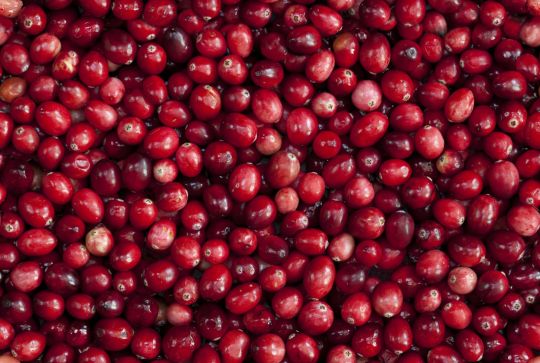
Folks Names: Bog fruit, Marshworts
Planet: Mars
Element: Water (juice), Fire (berry)
Deities: Astarte, Marjatta,
Abilities: Healing, Protection, Love, Lust, Positive Energy, Courage, Passion, Action
Characteristics: Native to Eastern North America and northern Asia. Small, slender, evergreen shrub growing to 1 ft with oval, dark green leaves, pink flowers and round/slightly pear-shaped red berries.
History: This jewel-toned gem of the bog is native to North America and a traditional food from Samhain through Yule. Its association with the American Thanksgiving meal is long rooted in tradition, but there is no historical evidence proving it was actually served at that first Thanksgiving celebrated by the Pilgrims. Despite this, cranberry something or other is commonly found on Thanksgiving and Christmas feast tables all across the United States, Canada, and the United Kingdom. Cranberry garlands made by stringing hundreds of the hard round red berries with a needle onto a long sturdy string is a traditional Christmas decoration. It is believed that cranberries got their name due to cranes always eating them and the blossoms of the berries look like the head of cranes. It is considered a sacred fruit in some indigenous circles such as Algonquian and Iroquois.
How to Grow:
Easy to Plant: Relatively
Rating: Moderate
Seeds accessible: Sometimes seasonal
How to Plant Cranberries
Video Guide
Where to Buy Seeds
Magical Properties
Can be used as a substitute for wine
Dried cranberries can be used in a charm to honor the wisdom of elders or as an offering to ancestors
It’s bright color signals energy, passion, courage, rejuvenation and rebirth
Can lend abundance, love and healing in kitchen spells
Since they are from the bog, it said to be feared by evil spirits and can offer protection
Placing a bowl of cranberries under one’s bed can restore depleted energy and cure an illness
Drinking the juice with your partner on a dark moon can keep your relationship free of trouble and continue to go strong
Can help link wisdom and guidance of ancestors
Can be utilized in energy cleansing rituals to remove negative energies from the aura
Is said to restore chakra alignment balance and create harmony
Burning bundles of cranberry stems can purify the energy of space and promote spiritual well-being during rituals and meditating
Medical Usage:
A classic remedy for urinary tract infections and can prevent and treat problems such as cystitis and urethritis
Can help to disinfect the urinary tubules and may be taken for problems associated with poor urinary flow such as enlarged prostate and blade infections
Can be used long term to prevent the development of urinary stones
Research in 1994 showed that cranberry juice helped really well with UTIs in women
Sources
#witch community#witchblr#witchcraft#paganblr#nature#witchcraft 101#plants and herbs#green witch#occulltism#cranberries#cranberry juice#cranberry sauce#kitchen witch#thanksgiving#fruits and vegetables#berries#baby witch
96 notes
·
View notes
Text
‼️This is a callout post‼️
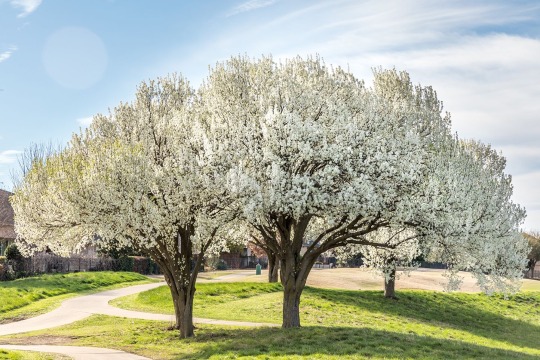
I hate these guys I hate them so much like actually who decided to start planting Bradford Pears they have Zero good qualities I HATE THEM SO MUCH
So here’s some reasons why you should get rid of these:
They smell like a fish market on a hot summer day but all the fish are a week old
The flowers aren’t that cool like sorry there’s plenty of other trees with white flowers
They are BRITTLE. SO BRITTLE. One gust of wind and your tree is GONE.
They will breed with anything. Whore tree. They cross-pollinate to a point where they become incredibly invasive. And also when they do that they grow thorns and get super ugly 👍
THEY’RE PEAR TREES THAT DON’T EVEN GROW PEARS
Did I mention they smell like fish
‼️‼️‼️‼️‼️‼️‼️‼️‼️‼️‼️‼️‼️‼️‼️ If you have Bradford Pears that you can cut down you should cut them down
Some US states will give you a free tree to replace them with
Here are some better trees to plant in your area:
*these are US based recommendations because I’m pretty sure the US is the only place with Evil Bradford Pear Problems*
Magnolias! They smell amazing and have great flowers. They’re native to Florida but will survive in most of the southeastern US
Dogwoods! There’s both an eastern and a western variety and both are native to North America! Just make sure you get the right type for where you live (east vs west)
Pawpaws! These trees bear fruit, are great for pollinators, and their native range spans about half of the United States
Redbuds! Similar to Dogwoods, there’s both an eastern and western variety. Also native to North America, they’re one of the first trees to bloom in spring
Serviceberry! YOU CAN EAT THE BERRIES!!! Also native to North America, they can survive in a ton of different climates and are great for pollinators
You can find more native trees here
This has been a Bradford Pear Hate Post
34 notes
·
View notes
Photo

Canyon de Chelly
Canyon de Chelly or Canyon de Chelly National Monument is a protected site that contains the remains of 5,000 years of Native American inhabitation. Canyon de Chelly is located in the northeastern portion of the US state of Arizona within the Navajo Nation and not too far from the border with neighboring New Mexico. It is located 472 km (293 miles) northwest of Phoenix, Arizona. Canyon de Chelly is unique in the United States as it preserves the ruins and rock art of indigenous peoples that lived in the region for centuries - the Ancestral Puebloans and the Navajo. Canyon de Chelly has been recognized as a US National Monument since 1931 CE, and it is one of the most visited National Monuments in the United States today.
Geography & Prehistory
The etymology of Canyon de Chelly's name is unusual in the U.S. Southwest as it initially appears to resemble French rather than the more ubiquitous Spanish. "Chelly" is actually derived from the Navajo word tseg, which means "rock canyon" or "in a canyon." Spanish explorers and government officials began to utilize a "Chelly,” “Chegui,” and even "Chelle" in order to try to replicate the Navajo word in the early 1800s CE, which eventually was standardized to “de Chelly” by the middle of the 19th century CE.
Canyon de Chelly lies very close to Chinle, Arizona, and it is located between the Ancestral Puebloan ruins of Betakin and Kiet Siel in the west and the grand structures of Chaco Canyon in New Mexico in the east. Canyon de Chelly, as a National Monument, covers 83,840 acres (339.3 km2; 131.0 sq miles) of land that is currently owned by the Navajo tribe. Spectacularly situated on the Colorado Plateau near the Four Corner's Region, Canyon de Chelly sits at an elevation of over 1829 m (6,000 ft) and bisects the Defiance Plateau in eastern Arizona. The tributaries of the Chinle Creek, which runs through Canyon de Chelly and originates in the Chuska Mountains, have carved the rock and landscape for thousands of years, creating red cliffs that rise up an additional 305 m (1000 ft). The National Monument extends into the canyons of de Chelly, del Muerto, and Monument.
Canyon de Chelly is one of the longest continuously inhabited places anywhere in North America, and archaeologists believe that human settlement in the canyon dates back some 5,000 years. Ancient prehistoric tribes and peoples utilized the canyon while hunting and migrating seasonally, but they did not construct permanent settlements within the canyon. Nonetheless, these prehistoric peoples did leave etchings on stones and on canyon walls throughout what is now Canyon de Chelly. Around c. 200-100 BCE, peoples following a semi-agricultural and sedentary way of life began to inhabit the canyon. (Archaeologists refer to these peoples as "Basketmakers." They are considered the ancestors to the Ancestral Puebloan Peoples.) While they still hunted and gathered like their prehistoric forebears, they also farmed the land where fertile, growing corn, beans, squash, and other small crops. It is also known that they grew cotton for textile production. Yucca and grama grass have grown in the canyon for several millennia, and indigenous people utilized these plants when making baskets, sandals, and various types of mats. Prickly pear cactus (Opuntia cactaceae) and pinyon are also found throughout Canyon de Chelly, the latter of which provided an important source of food for indigenous peoples in autumn and winter. Fish are found in Canyon de Chelly's tributaries, and large and small game frequent the canyon.
Continue reading...
50 notes
·
View notes
Text
[A] luscious Owari Satsuma citrus tree, whose species was originally imported from Japan, currently experiencing the ravaging effects of an aphid infestation. [...] Where did they come from? [...] And a question that nineteenth- and twentieth-century individuals may have added is, who is to blame? Jeannie N. Shinozuka’s monograph, Biotic Borders: Transpacific Plant and Insect Migration and the Rise of Anti-Asian Racism in America, 1890-1950 [...] [examines] such human and nonhuman interconnections [...] [and] meditates on such questions in the historical setting of the American empire, including its transpacific borderland.
Toward the end of the nineteenth and through the twentieth century, the already present anti-Asian racism in the United States was infused with a conservationist attitude of sustainable yield and efficient use of the vast but vanishing natural resources of North America.
---
Unsurprisingly, these racial anxieties appeared just as the American empire expanded well beyond the continent’s borders. The economic threat of chestnut blight or citrus scale played into a native invasive binary that conveniently placed blame for the species’ decline, along with pest and disease introductions, on poor and immigrant groups, while excluding and erasing a longer colonial history of importations of destructive plants and animals by colonial and antebellum planters. These fears were founded not just in the economics of decline, based on a fear of the threat posed to cash crops often grown on increasingly large-scale farms, but also in jealousy surrounding agricultural innovations [...] of certain immigrant farmers [...] in a society plagued with racial anxieties of a so-called yellow peril. Paradoxically, wealthy American citizens interested in beautifying landscapes often held an orientalist fascination with a fetishized and consumable version of a Japanese countryside in the form of tea gardens. [...]
---
The work also discusses the role of newly ordained technocratic officials in giving supposed scientific validity to attitudes toward plant, animal, and human invaders from the Orient.
Plant biologists such as [D.F.] and entomologists [...] were on the forefront of crusades to prevent economically damaging insects and plant diseases from entering the borders of the United States and “degrading” the native stock. Many of these individuals, like [D.F.], were closely associated with some of the leading eugenicist organizations, for example, the American Breeder’s Association, within the United States. Their efforts at plant quarantine culminated in Plant Quarantine Number 37, or PQN 37, a law intended to prevent diseases and infection from foreign animal and plant bodies. This law set a precedent for similar policies regulating humans perceived as alien, including the Immigrant Act of 1924, which limited immigrants from southern and eastern Europe, while completely excluding individuals from Asia. Similarly, officials, [...] [entomologists] included among them, seized and destroyed the property of Japanese immigrants [...].
---
Shinozuka’s work is [...] a contribution to environmental history and Asian studies, [and] it is also a fresh conversation on borderlands and the role that [...] migrant groups, played in such porous places as the US Mexico border and Hawaii, the Pacific gateway to the US empire. Both domains offered opportunities to immigrants and scientists alike [...]. [I]mmigrant labor provided muscle power to corporate-owned American sugar plantations in Hawaii while also experiencing accusations of importing such damaging insects as the termite or Oriental beetle. What Shinozuka makes clear is that while these insects may have originated in southeast Asia, their spread was enabled by the context of American colonialism and empire. The trifold factors of urbanization, industrialization, and monocrop agriculture, all promoted in the interest of American business and marketed as a modernization effort in supposedly backward places like Hawaii, created the perfect circumstances for insects to swarm and disease to spread.
---
All text above by: Jacob Gautreaux. "Review of Shinozuka, Jeannie N., Biotic Borders: Transpacific Plant and Insect Migration and the Rise of Anti-Asian Racism in America, 1890-1950". H-Environment, H-Net Review. August 2024. At: h-net dot org slash reviews/showrev.php?id=60450. [Bold emphasis and some paragraph breaks/contractions added by me. Presented here for commentary, teaching, criticism purposes.]
14 notes
·
View notes
Text
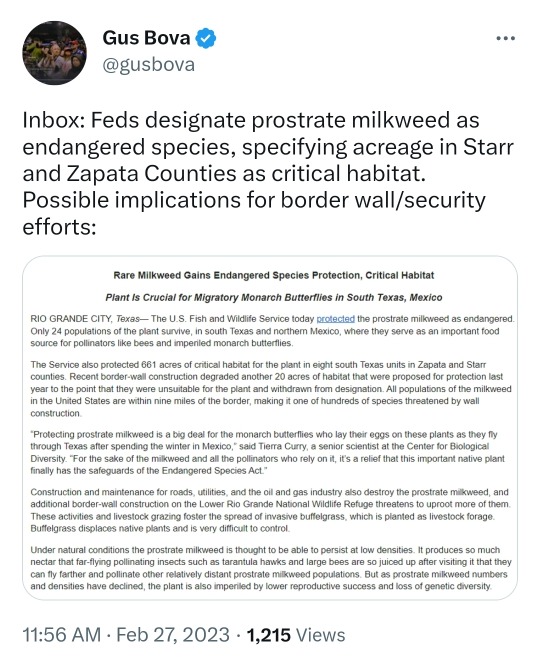
Text is from the Center for Biological Diversity:
For Immediate Release, February 27, 2023
Contact:
Tierra Curry, (928) 522-3681, [email protected]
Rare Milkweed Gains Endangered Species Protection, Critical Habitat
Plant Is Crucial for Migratory Monarch Butterflies in South Texas, Mexico
RIO GRANDE CITY, Texas— The U.S. Fish and Wildlife Service today protected the prostrate milkweed as endangered. Only 24 populations of the plant survive, in south Texas and northern Mexico, where they serve as an important food source for pollinators like bees and imperiled monarch butterflies.
The Service also protected 661 acres of critical habitat for the plant in eight south Texas units in Zapata and Starr counties. Recent border-wall construction degraded another 20 acres of habitat that were proposed for protection last year to the point that they were unsuitable for the plant and withdrawn from designation. All populations of the milkweed in the United States are within nine miles of the border, making it one of hundreds of species threatened by wall construction.
“Protecting prostrate milkweed is a big deal for the monarch butterflies who lay their eggs on these plants as they fly through Texas after spending the winter in Mexico,” said Tierra Curry, a senior scientist at the Center for Biological Diversity. “For the sake of the milkweed and all the pollinators who rely on it, it’s a relief that this important native plant finally has the safeguards of the Endangered Species Act.”
Construction and maintenance for roads, utilities, and the oil and gas industry also destroy the prostrate milkweed, and additional border-wall construction on the Lower Rio Grande National Wildlife Refuge threatens to uproot more of them. These activities and livestock grazing foster the spread of invasive buffelgrass, which is planted as livestock forage. Buffelgrass displaces native plants and is very difficult to control.
Under natural conditions the prostrate milkweed is thought to be able to persist at low densities. It produces so much nectar that far-flying pollinating insects such as tarantula hawks and large bees are so juiced up after visiting it that they can fly farther and pollinate other relatively distant prostrate milkweed populations. But as prostrate milkweed numbers and densities have declined, the plant is also imperiled by lower reproductive success and loss of genetic diversity.
Just 24 populations of prostrate milkweed remain in Starr and Zapata counties in Texas and in Tamaulipas and eastern Nuevo León in Mexico. Nineteen of those populations are rated in low condition, the remaining five are in moderate condition and none are in high condition — indicating acute imperilment.
The Endangered Species Act has been successful in keeping more than 99% of species under its protection from going extinct. But long delays in adding animal and plant species to the endangered list have heightened the perils and made recovery more difficult and expensive. For example, the Service must decide by the end of 2024 whether to protect monarch butterflies as threatened, 10 years after a petition seeking to protect them under the Endangered Species Act was filed.
The prostrate milkweed listing comes in response to a Center lawsuit to gain final decisions on protection for 241 plant and animal species threatened with extinction, including the prostrate milkweed and more than 35 others in Texas. The prostrate milkweed was the subject of a 2007 protection petition by WildEarth Guardians.
The prostrate milkweed’s low and sprawling leaves and stem wilt during droughts. But the plant’s subterranean tuber stays alive and after soaking up moisture from occasional tropical storms sends up stalks and pink and yellow flowers.
175 notes
·
View notes
Text
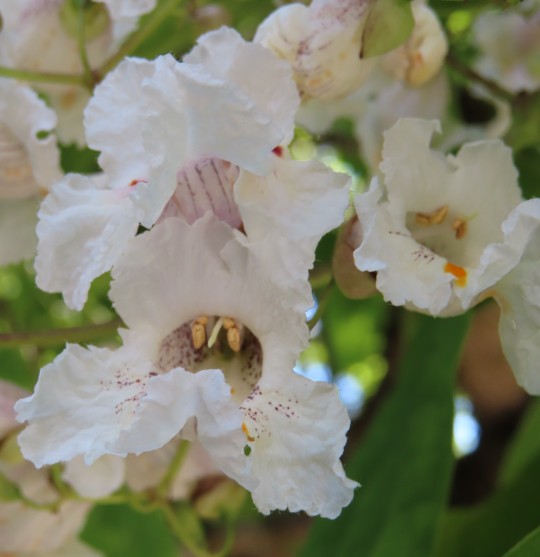
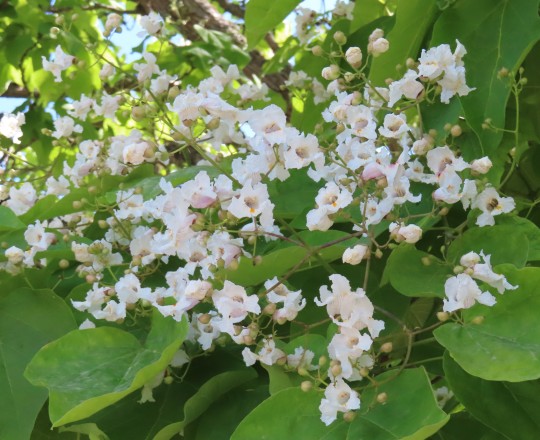
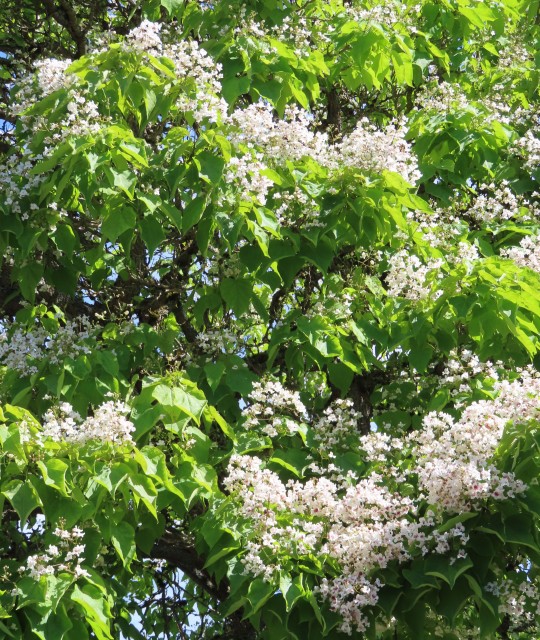
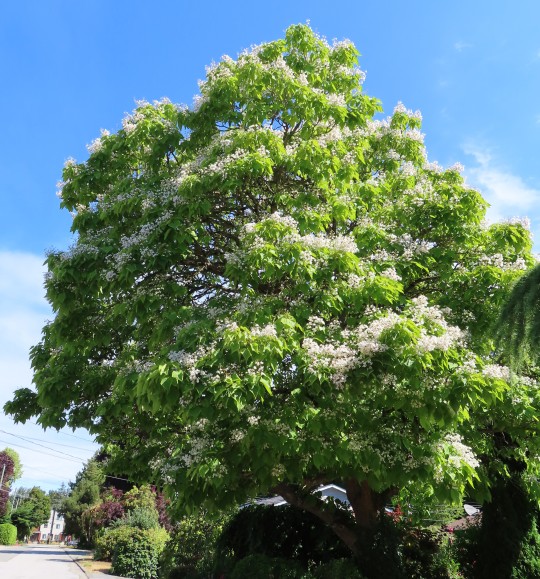
Catalpa bignonioides (southern catalpa)
The southern catalpa is native to the south eastern United States but this fifty foot tall specimen is growing as a 'street tree' in my Vancouver neighborhood. When attacked by caterpillars this tree has special glands that produce nectar on its wounded leaves. Nectar is confined to the flowers in most plants and leaves making nectar is very rare. This nectar attracts a great number of bodyguard ants (Forelius pruinosus) and, in addition to lapping up the sweet stuff, the ants make short work of any caterpillars they find.
This tree has another trick up its sleeve. Each flower has both stamens (the boy part) and a stigma (the girl part). However, the stigma doesn't open until the stamens have given up all of their pollen and withered. This ensures that the flower doesn't accidently pollinate itself.
#flowers#photographers on tumblr#catalpa#flowering tree#street tree#fleurs#flores#fiori#blumen#bloemen#flower photography#vancouver
121 notes
·
View notes
Text
Excerpt from this Margaret Renkl Op-Ed from the New York Times:
Until last fall, when PBS screened “The American Buffalo,” a documentary by Ken Burns, I had no idea bison were native to Middle Tennessee, where I have lived for 37 years. I just assumed that Nashville was part of the great temperate deciduous forests that once covered much of the eastern half of the United States.
I should’ve guessed that the picture was more complicated. When I went looking for the once-endangered Tennessee coneflower in 2019, I found them in a rocky glade surrounded by grasslands blooming with wildflowers. And if there are grasslands here now, surely there must have been grasslands here in the past.
Before the European settlers arrived in North America, the region we know today as the American South was home to seven to 10 million acres of prairie, according to Dwayne Estes, a botanist, professor of biology at Austin Peay State University in Clarksville, Tenn., and executive director of the Southeastern Grasslands Institute, which works to research, preserve and restore native grasslands across the South. Today nearly all those Southern prairies — along with nearly all the other types of Southern grassland ecosystems, and nearly all the plants and animals they supported — are gone.
The scope of this loss of is enormous. Until the early 18th century, the South had up to 120 million acres of grasslands — prairies, savannas, wet meadows, barrens, glades, fens, marshes, coastal dunes, balds and riverscour that collectively supported a truly breathtaking array of plants and animals. In a study published in 2021, a team of scientists including Dr. Estes identified 118 major types of grassland ecosystems in the South. Some are close to extinction.
The most widespread were the savannas, grasslands characterized by scattered trees and a wildflower-rich soil. Historically, what kept young trees from filling the grasslands and turning them into dense, closed-canopy forests were two things: fire and bison (or both). “If you take fire and bison off savanna grasslands, which we did for the first time in world history, they will naturally grow up into trees,” Dr. Estes said in an interview. “They will become what we call artificial forests.” By the end of the 19th century, both bison and fire had been largely eliminated from the Southern landscape.
We know the European settlers chopped down much of the Eastern hardwood forests to harvest timber, but the ecological devastation wrought by a belief in Manifest Destiny didn’t stop with deforestation. The grasslands began to disappear, too, as trappers and settlers slaughtered the bison and suppressed the fire and turned the rich soil into farms.
Between row-crop agriculture, urban sprawl, and the transformation of open woodlands into closed-canopy forests, among other human encroachments, there is almost nothing left of the original grassland ecosystems that once sustained the immense biodiversity of the American South, from tiny insects to grasslands birds to the great buffalo itself. The grassy places we still have — pastures, public parks, highway medians and the like — don’t serve the same ecological function that our native grasslands did. These days, “grass” means species imported from Europe and Asia, monocultures that don’t support diverse plant species or native wildlife.
Today, according to calculations by the Southeastern Grasslands Institute, less than 5 percent of our original grasslands still exist. “Yet the remaining scraps include more grassland plants and animals than the Great Plains and Midwest combined,” notes Janet Marinelli in the publication Yale Environment 360. Preserving these remnants is vital, and not just for the biodiversity they sustain. Grassland remnants tell ecologists what a nearby grasslands-restoration project should look like, and they can serve as seed stock for propagation fields that will in turn provide the seeds needed to return the landscape to itself.
8 notes
·
View notes
Text
So growing up I heard these kinds of statements: "X number of species goes extinct every year" and "Most species that go extinct are undescribed/undiscovered"
And I could never really picture what that looked like. What species were going extinct? Where? Why? If they're undiscovered, how do we know about it? It's only recently that I've been able to understand.
This is an example:
Since European colonization, 99% of old growth forest in the eastern United States was cut down.
In Eastern Kentucky, the coal industry led to waste and rubble being dumped in valleys, literally burying countless mountain streams in gravel and toxic sludge.
Colonialism and exploitation moved faster than leaf-sketching and bug-collecting European naturalists did. It's very simple, and very sad. When the coal mines polluted the streams, many species of fish that only lived in one specific stream must have gone extinct. When Native Americans were forced off their lands, we can presume that rare plant species found in meadows, canebrakes and oaks savannas dependent on particular anthropogenic disturbances went extinct. When old-growth tracts were logged, God only knows how many lichens, mosses, ferns and plants went extinct because the trees they lived on were chopped.
We can extrapolate from the diversity in the fragments that remain, and the number of rare endemic species in especially isolated areas, and guess what probably existed in areas that were obliterated early on.
Keep in mind: All is not lost. New species are still being discovered.
The Bluegrass region of Kentucky was once called one of the most peculiar plant communities of the South—an eastern island of oak savanna with an understory of Arundinaria bamboo and legumes. Early European settlers reported that the ground was incredibly rich and covered with knee-high clover and dense thickets of "cane" (bamboo) that made navigation next to impossible.
Some people say the Bluegrass was always a forest and the savanna theory is wrong. Bullshit! I know this because of several reasons:
The earliest records don't mention any sycamores at all in the Bluegrass, whereas river cane (bamboo) was everywhere. Arundinaria bamboos are fire dependent species, whereas sycamore is HIGHLY intolerant of fire. From this we can infer that the area had a history of frequent burning.
Everyone in the Bluegrass knows about the Old Trees. In horse and cattle pastures in the Bluegrass region, you will sometimes see gigantic, twisted old oaks, with great spreading crowns. Nowadays you hardly see an oak that properly merits the term "gnarled," but the gnarl of the Old Trees is crazy. Just look up google images for Kentucky tourism and you'll see one of those huge trees in the background of several of the photos, I bet. Hardly anyone consciously thinks about it, but these are pre-colonization trees. And they are all obviously open-grown—their growth habit over the centuries has spread out, rather than grown straight up as in a forest.
Early colonizers' records report big walnut and cherry trees in the area. Most of the old houses in the area are made of walnut wood. Those are mid-successional species—you wouldn't find them dominating in an area that was heavily disturbed regularly and recently, they're trees, but you wouldn't find them in a forest that had been minimally disturbed forest for centuries either. The fact that they got huge suggests that a regular disturbance pattern of the Bluegrass region was abruptly interrupted and mostly ceased.
It was a pretty special place, a savanna environment with a mix of giant twisted oaks, rolling prairie hills and bamboo thickets, with deep sinkholes connecting the surface to subterranean cave ecosystems. In places the limestone bedrock reached the surface, creating limestone glades—unique desert-like habitats with many rare plants including Opuntia cactus.
It was also one of the first ecosystems west of the Appalachians to be destroyed by settlers.
BUT! Just a few years ago, we discovered Trifolium kentuckiense—Kentucky clover. A unique species of clover that has only been found in two spots in Central Kentucky.
This means the Bluegrass species that probably went extinct because their habitat was ignorantly logged, plowed and grazed before they were studied by European science may not be entirely gone.
We have been able to fund exhaustive inventories of potential holdouts for big flashy animals like the ivory-billed woodpecker, but so many people view the place they live as "boring" and thoroughly explored, when there could be surviving plants hanging out just about anywhere.
But...I don't think most people realize how much of the Holocene extinction has already happened. Most of the losses are plants and bugs that you never knew existed in the first place.
I feel like lots of people are anxiously waiting for the mass extinction to "start" hitting, but that's not quite right. European colonization of the globe WAS and *is* the mass extinction (combined with climate change which is very related). It's actively ongoing in the Global South. In eastern North America, the major wave of extinctions hit between 100 and 300 years ago.
I feel so much grief for all that was almost certainly lost forever, but I also recognize that I live in a unique period of time where the future can still be changed, and in particular, the heavily damaged ecosystems of the Southeast can be restored and used to absorb carbon from the atmosphere and provide resilience to the entire globe. And I strongly suspect at least a few mysterious new plants will start popping up once that happens...because a lot of plants stick around in the soil seed bank for a long, long time, and seeds can happen to be preserved by freak accident and then sprout later.
we (researchers, scientists, people who work in this field) will desperately need to consult tribal nations for this though because from my reading into it, we don't know what the fuck we're doing. The most basic things like controlled burns are still struggling to catch on and in some places just, spraying herbicides willy-nilly on invasive plants without understanding what makes them invasive.
1K notes
·
View notes
Text

The full moon in April is known as the pink moon, named after the herb moss pink, also known as creeping phlox, moss phlox or mountain phlox. This is a plant native to the eastern United States that is one of the earliest widespread flowers of spring. [x]
Goddess Moon Print by HolgaJen
13 notes
·
View notes
Text
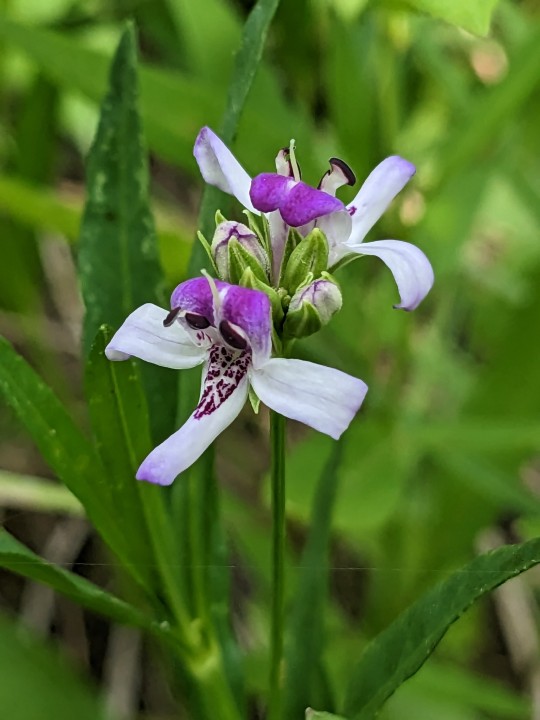
American Water Willow
Justicia americana
This native perennial loves water and can be found in very moist habitats. Its native range spans from Texas, throughout much of the eastern United States, to southeastern Canada. I found this blooming plant with purple and white bicolored flowers among a small colony growing in the middle of a shallow creek.
June 6, 2023
Shannon County, Missouri, USA
Olivia R. Myers
@oliviarosaline
#botany#plants#native plants#native flowers#flowers#nature#ozarks#the ozarks#naturecore#missouri#fairycore#wetlands#aquatic plants#wildflowers#wild flowers#goblincore#cottagecore#Justicia americana#Justicia#water willow#american water willow#Acanthaceae#Dianthera americana#Dianthera#Missouri nature#plants of the ozarks#plants of tumblr#hiking#exploring nature#plant photography
62 notes
·
View notes
Text

Mab’s Drawlloween Day 10: Pumpkin
Meet the Ozark wild gourd (curcurbita pepo var. ozarkana) aka “johnny gourd”. It’s vines, leaves, and orange flowers look like most squash plants, but its bitter poisonous squash look like white chicken eggs and are around the same size. I call them ghost eggs, but your state may have its own folk names for it as well as yellow or green varieties of it. The squash may be inedible, but the seeds are edible, plentiful, and high in protein. Before the 1980s it was thought to be a garden escapee, but then researchers noticed it happily growing wild along many rivers in the eastern US states and decided to study it. When they did, they realized it wasn’t like any other squash and was in fact the wild ancestor of potentially all edible and ornamental squash in North America.
This was a big deal because it changed agricultural history. All squash and pumpkins were previously thought to originate in Mexico 8,000 years ago and agriculture and plant cultivation by indigenous peoples wasn’t thought to have happened in the US at all. Seeds of the wild Ozark squash have since been found at multiple excavations sites in the US dating back to 7,000 years and more seeds showing signs of cultivation and early agriculture date back to 3,000 to 4,000 years —predating the Mississippian culture. Archaeologists have provided ample irrefutable evidence against the longstanding racist views of the Native peoples of the United States thanks to this unassuming wild squash.
“The fourth-known prehistoric plant to have been domesticated in North America and is important new evidence that eastern North America was one of the world’s independent centers of plant domestication and agricultural development.”
Source: Barrat, John. “United States Finally May Have a Vegetable It Can Call Its Own : Food: Archeologists have discovered a small, wild gourd that they believe is the ancestor of today’s summer squashes.” Los Angeles Times, November, 1992.
#bane folk#wild ozark squash#curcurbita pepo var ozarkana#poisonous plants#poison path#inktober#mabsdrawlloweenclub#mabsdrawlloween2023#mdwc23#mdwc23d10
23 notes
·
View notes
Text
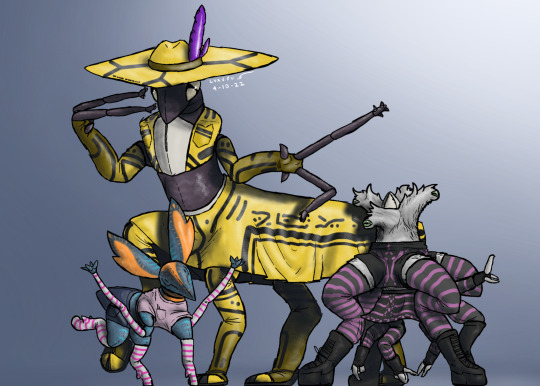
as an early celebration of what I believe is the common consensus of Femboy day, here's some "femboy" sophonts I drew last year to celebrate this unofficial holiday. Each description is ordered clockwise to their respective sophont
The Arrtas (pronounced with a trilling R) are a sapient species of 10 foot tall arthropod-like Centaurs. They hail from the sprawling savannahs of a temperate planet that is home to purple horsetail-like plants and large arthropod-like hexapods, an interesting feature is that there is a single supercontinent that stretches across the western equator to the south-eastern hemisphere. The snout on their heads is actually a sheath for a hollow space connected to their respiratory system that allows them to produce vowels. And they can produce a clicking sound using an 8 jawed mouth located on their upper chest. They have developed a culture similar to 1920's America, but without all the racism and sexism and homophobia. And unlike the united states during this time period, they have never experienced any great depression, allowing this culture to proliferate and continue on. Their gender norms are also nearly non-existent. So most Arrta are androgynous or nonbinary. And due to the abundance of purple flora on their homeworld, wearing yellow clothing is a sign of prestige and wealth
The Lortexi are a sapient species of radially symmetrical, mammal-like organisms native to a planet locked in a permanent ice age. For the longest time, their civilization has been ruled and governed by only a single faction. A large and omnipresent Technocracy that has abandoned all ethics and any moral compass, seeing them as an obstacle in their pursuit of knowing everything. While this has allowed the Lortexi to know everything about the body and developed cures for every known disease and disorder, this also means that they have committed countless crimes against humanity with their experiments. But luckily it would come to and end when they eventually lose a war with a rival civilization and are forced to be ethical once again. During early space exploration and colonization of nearby star systems. A counterculture had developed that visually opposed the bright and simple cleanliness of most technocrats with the alien equivalent of Emo. Due to the technocracy's eagerness and curiosity about this counter-culture, they have studied and researched nearly everything about them.
The Q-ri-Zocs are a sapient species of tripods native to a former paradise planet now recovering from the scars of nuclear war. Wildlife of their homeworld consists of blue fern-like flora and 5 limbed arthropod-like fauna. Most Q-ri-zocs are ruled by matriarchs, not just in society, but even in biology. Males of the species are usually colorful and energetic, but are weak and stand at a height of 3-4 feet. Meanwhile the females are a dull gray but are very strong and stand at a height of 6-7 feet tall. However because of this, societal problems such as sexism and transphobia have been prevalent for a very long time with constant internal conflicts between frustrated males that are treated as mere property and power hungry matriarchs who will stop at nothing to keep the males subserviently. This constant clash has only accelerated further when the Q-ri-Zocs made first contact with other alien civilizations. This would end in an all out revolt that ends in a victory for the once discriminated males, and for the first time in eons, male Q-ri-zocs are finally treated equally within their own societies.
Each species in this art piece is from a personal project detailing the history of the universe and the countless civilizations
#speculative zoology#speculative biology#alien#alien species#a story of our universe#my art#artist on tumblr#scifiart#worldbuilding#sophont
73 notes
·
View notes